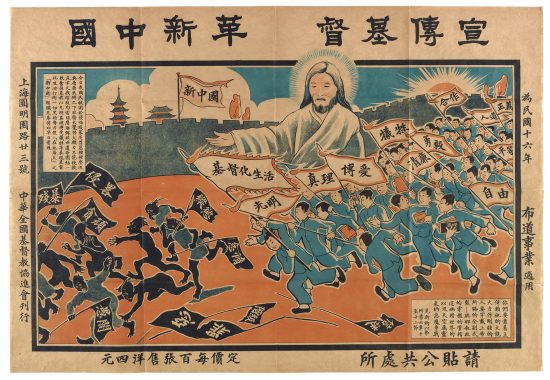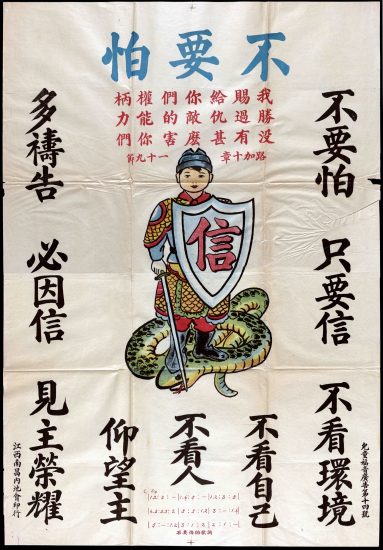
Bridge of Salvation:
This first poster depicts young men trying to traverse a chasm to reach a heavenly light emanating from behind a cross. The artist labels the depicted figures using text, as well as describing their intent with two captions. The young men are trying to use boards labeled 善行(good acts), 功德(virtue), and 宗教 (piety) to get across the chasm of 罪与刑罚(sin and punishment) and reach 赦免与永生 (Forgiveness and eternal life). However, their boards are not long enough, with the only road to Christ being 悔改信耶稣 (repentance and belief in Jesus.) The caption conveys the meaning of this little parable- the author believes that humans are sinful and not deserving of God, regardless of deeds, and that salvation can only be found through repentance and God’s Mercy. The poster uses a simple graphical style, opting for cartoonish depictions of people. It’s worth noting that the men are wearing Western Clothing. The poster feels to have a relatively standard message of Christian thought in the context of the archive, espousing the value of loyalty to God. It is a rather effective poster- the message is clear, graphically, although people in other regions might have difficulty interpreting the labels. However, like Joseph Ho enumerated upon in his article, the image is able to tell a clear story, making it that much more powerful. The image does rely primarily on text-based communication, rather than mostly upon a cartoon with labels, which makes it relatively standard in context. I wish I could learn more about the Christian Witness Press in Hong Kong that published the poster.

Preach Christ, Reform China:
In this second poster, Jesus Christ is watching over an army of excited young Chinese men waving white flags driving out terrified black figures of indeterminate origin waving black flags. The poster is centered around the cartoon, with text labels differentiating the beliefs of the two groups of people, on a background of Chinese architecture. The poster again uses a simple cartoon style, but there is more detail on the human figures than in Bridge of Salvation. When translating the flags, one will find that the Chinese men are waving flags that read Justice, Cooperation, Sacrifice, Christian Life, etc, while the black figures are abandoning their flags of Laziness, Cruelty, Evil, etc. The flag over the buildings in the background reads 新中国 (New China). Reading these flags, (along with the relatively straightforward captions,) the authors message becomes clear. It is the job of Christians to drive out the weaknesses of existing societies, and to create a new China that is free of evil. This is a strong message that nearly crosses the border from evangelism to nationalism. It’s interesting how the National Christian Council of China (the poster’s creators) focus more on virtue and righteousness instead of devotion, unlike the Christian Witness Press.

Do Not Be Afraid:
This final poster, a children’s gospel published by Jiangxi Nanchang China Inland Mission, takes a less fiery approach and has a more didactic intent. A friendly-faced warrior with a sword and shield is standing over a conquered snake, surrounded by text. The poster is more in line with many posters in the greater gallery compared to the other two in this exhibit due to its heavy reliance on text to convey its message. The captions have a message telling the reader to not be afraid of the power of enemies and sin, and not to make the mistake of relying on anything other than the power of God and Christ. The Warrior’s shield reads 信 (faith), reinforcing the message of piety being a protective and holy thing. This poster is probably the most difficult to transplant culturally due to its reliance on Chinese Characters. However, being intended for children, it is effective in its purpose of providing child-friendly reinforcement of Christian Values.
The Meaning of Absolute Faith and the requirements of Salvation
I chose these posters because their intent of teaching the reader the correct method of reaching salvation through christ fascinated me. Although I disagree with their rather fatalist approach, these posters in particular appealed to a sense of “christian pride” in me, which is particularly scintillating when considering the fact that many of the same techniques used here are those used for nationalist propaganda. However, the difference in gospels, such as Bridge of Salvation’s focus on faith and repentance being the only way to cross the pit, while Preach Christ is dedicated to individual virtues driving out weakness in the name of christ, leads to an interesting dynamic of how minor differences in though could lead to these non-unified appeals to religious sensibility. Were I an illiterate person reading these posters (I can’t read a single character of Chinese, so I may effectively be exactly that), I would probably be able to understand that they all conveyed a message of trusting in Good Things, whatever those Good Things might be. Preach Christ is probably the simplest to understand without having to read any characters, but the depictions in the other two are relatively straightforward as well.
